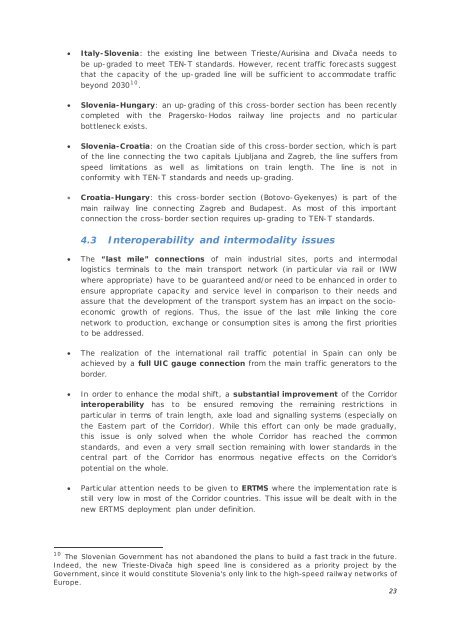Mediterranean
5Lwz6ndOG
5Lwz6ndOG
Create successful ePaper yourself
Turn your PDF publications into a flip-book with our unique Google optimized e-Paper software.
• Italy-Slovenia: the existing line between Trieste/Aurisina and Divača needs to<br />
be up-graded to meet TEN-T standards. However, recent traffic forecasts suggest<br />
that the capacity of the up-graded line will be sufficient to accommodate traffic<br />
beyond 2030 10 .<br />
• Slovenia-Hungary: an up-grading of this cross-border section has been recently<br />
completed with the Pragersko-Hodos railway line projects and no particular<br />
bottleneck exists.<br />
• Slovenia-Croatia: on the Croatian side of this cross-border section, which is part<br />
of the line connecting the two capitals Ljubljana and Zagreb, the line suffers from<br />
speed limitations as well as limitations on train length. The line is not in<br />
conformity with TEN-T standards and needs up-grading.<br />
• Croatia-Hungary: this cross-border section (Botovo-Gyekenyes) is part of the<br />
main railway line connecting Zagreb and Budapest. As most of this important<br />
connection the cross-border section requires up-grading to TEN-T standards.<br />
4.3 Interoperability and intermodality issues<br />
• The “last mile” connections of main industrial sites, ports and intermodal<br />
logistics terminals to the main transport network (in particular via rail or IWW<br />
where appropriate) have to be guaranteed and/or need to be enhanced in order to<br />
ensure appropriate capacity and service level in comparison to their needs and<br />
assure that the development of the transport system has an impact on the socioeconomic<br />
growth of regions. Thus, the issue of the last mile linking the core<br />
network to production, exchange or consumption sites is among the first priorities<br />
to be addressed.<br />
• The realization of the international rail traffic potential in Spain can only be<br />
achieved by a full UIC gauge connection from the main traffic generators to the<br />
border.<br />
• In order to enhance the modal shift, a substantial improvement of the Corridor<br />
interoperability has to be ensured removing the remaining restrictions in<br />
particular in terms of train length, axle load and signalling systems (especially on<br />
the Eastern part of the Corridor). While this effort can only be made gradually,<br />
this issue is only solved when the whole Corridor has reached the common<br />
standards, and even a very small section remaining with lower standards in the<br />
central part of the Corridor has enormous negative effects on the Corridor’s<br />
potential on the whole.<br />
• Particular attention needs to be given to ERTMS where the implementation rate is<br />
still very low in most of the Corridor countries. This issue will be dealt with in the<br />
new ERTMS deployment plan under definition.<br />
10 The Slovenian Government has not abandoned the plans to build a fast track in the future.<br />
Indeed, the new Trieste-Divača high speed line is considered as a priority project by the<br />
Government, since it would constitute Slovenia's only link to the high-speed railway networks of<br />
Europe.<br />
23



